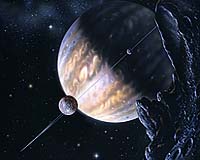Researchers at the University of Colorado, while simulating on supercomputers four closely positioned solar systems containing large planets comparable in size to Jupiter—the largest planet in our Solar System—have discovered a solar system with a potentially habitable Earth-like planet.
 The second solar system features a belt of rocky objects the size of Mars or smaller. The other two solar systems do not possess the necessary conditions to form a planet the size of Earth.
The second solar system features a belt of rocky objects the size of Mars or smaller. The other two solar systems do not possess the necessary conditions to form a planet the size of Earth.
Experts indicate that each of these solar systems exists approximately 250 light-years away from Earth in the universe. Each solar system contains at least two large planets comparable in size to Jupiter, which orbit closely around their stars, potentially in proximity to Mercury and the Sun.
Scientist Sean Raymond stated that for each solar system, they conducted 10 computer simulations. They placed smaller planets in the early stages into a solar system to investigate whether they could combine with other materials to form a true planet the size of Earth.
“Our research indicates that there is a potentially habitable planet, one with mass, temperature, and water similar to Earth, that could form in one of the discovered planetary systems,” said Rory Barnes, a co-author of the study.
The conditions for planet formation in this new solar system could remain stable for up to 100 million years, the time required for embryonic planets to gather material and gradually develop into planets the size of Mars or Earth.
TUONG VY


















































